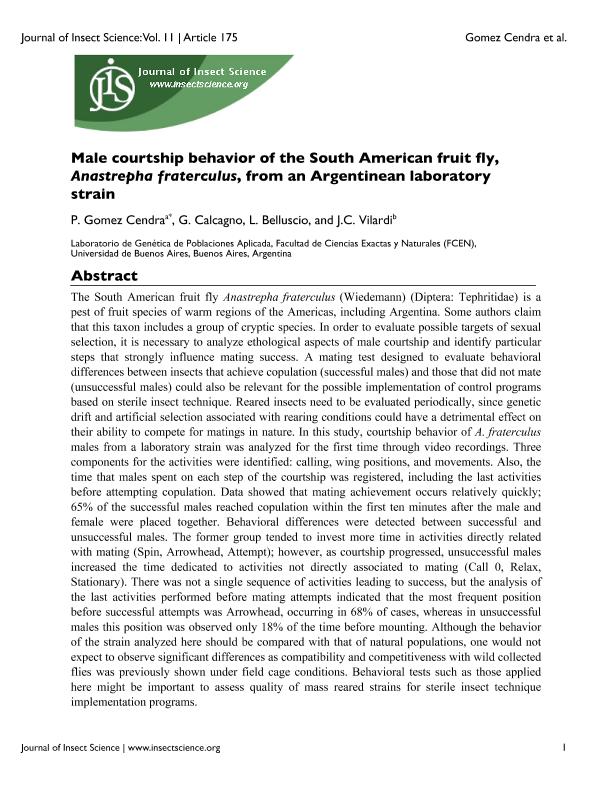Mostrar el registro sencillo del ítem
dc.contributor.author
Gómez Cendra, Paula Valeria

dc.contributor.author
Calcagno, G.
dc.contributor.author
Belluscio, Laura María

dc.contributor.author
Vilardi, Juan Cesar

dc.date.available
2019-01-25T17:45:18Z
dc.date.issued
2011-12
dc.identifier.citation
Gómez Cendra, Paula Valeria; Calcagno, G.; Belluscio, Laura María; Vilardi, Juan Cesar; Male courtship behavior of the south american fruit fly, anastrepha fraterculus, from an Argentinean laboratory strain; University of Arizona; Journal of Insect Science; 11; 1; 12-2011; 1-18
dc.identifier.issn
1536-2442
dc.identifier.uri
http://hdl.handle.net/11336/68630
dc.description.abstract
The South American fruit fly Anastrepha fraterculus (Wiedemann) (Diptera: Tephritidae) is a pest of fruit species of warm regions of the Americas, including Argentina. Some authors claim that this taxon includes a group of cryptic species. In order to evaluate possible targets of sexual selection, it is necessary to analyze ethological aspects of male courtship and identify particular steps that strongly influence mating success. A mating test designed to evaluate behavioral differences between insects that achieve copulation (successful males) and those that did not mate (unsuccessful males) could also be relevant for the possible implementation of control programs based on sterile insect technique. Reared insects need to be evaluated periodically, since genetic drift and artificial selection associated with rearing conditions could have a detrimental effect on their ability to compete for matings in nature. In this study, courtship behavior of A. fraterculus males from a laboratory strain was analyzed for the first time through video recordings. Three components for the activities were identified: calling, wing positions, and movements. Also, the time that males spent on each step of the courtship was registered, including the last activities before attempting copulation. Data showed that mating achievement occurs relatively quickly; 65% of the successful males reached copulation within the first ten minutes after the male and female were placed together. Behavioral differences were detected between successful and unsuccessful males. The former group tended to invest more time in activities directly related with mating (Spin, Arrowhead, Attempt); however, as courtship progressed, unsuccessful males increased the time dedicated to activities not directly associated to mating (Call 0, Relax,Stationary). There was not a single sequence of activities leading to success, but the analysis of the last activities performed before mating attempts indicated that the most frequent position before successful attempts was Arrowhead, occurring in 68% of cases, whereas in unsuccessful males this position was observed only 18% of the time before mounting. Although the behavior of the strain analyzed here should be compared with that of natural populations, one would not expect to observe significant differences as compatibility and competitiveness with wild collected flies was previously shown under field cage conditions. Behavioral tests such as those applied here might be important to assess quality of mass reared strains for sterile insect technique implementation programs.
dc.format
application/pdf
dc.language.iso
eng
dc.publisher
University of Arizona

dc.rights
info:eu-repo/semantics/openAccess
dc.rights.uri
https://creativecommons.org/licenses/by-nc-sa/2.5/ar/
dc.subject
Mating
dc.subject
Sterile Insect Technique
dc.subject
Tephritids
dc.subject.classification
Otras Ciencias Biológicas

dc.subject.classification
Ciencias Biológicas

dc.subject.classification
CIENCIAS NATURALES Y EXACTAS

dc.title
Male courtship behavior of the south american fruit fly, anastrepha fraterculus, from an Argentinean laboratory strain
dc.type
info:eu-repo/semantics/article
dc.type
info:ar-repo/semantics/artículo
dc.type
info:eu-repo/semantics/publishedVersion
dc.date.updated
2019-01-25T13:36:14Z
dc.journal.volume
11
dc.journal.number
1
dc.journal.pagination
1-18
dc.journal.pais
Estados Unidos

dc.description.fil
Fil: Gómez Cendra, Paula Valeria. Universidad de Buenos Aires. Facultad de Cs.exactas y Naturales. Departamento de Ecología, Genética y Evolución. Genética de Población Aplicadas; Argentina. Consejo Nacional de Investigaciones Científicas y Técnicas; Argentina
dc.description.fil
Fil: Calcagno, G.. Universidad de Buenos Aires. Facultad de Cs.exactas y Naturales. Departamento de Ecología, Genética y Evolución. Genética de Población Aplicadas; Argentina
dc.description.fil
Fil: Belluscio, Laura María. Universidad de Buenos Aires. Facultad de Ciencias Exactas y Naturales. Departamento de Ecología, Genética y Evolución; Argentina. Consejo Nacional de Investigaciones Científicas y Técnicas; Argentina
dc.description.fil
Fil: Vilardi, Juan Cesar. Universidad de Buenos Aires. Facultad de Cs.exactas y Naturales. Departamento de Ecología, Genética y Evolución. Genética de Población Aplicadas; Argentina. Consejo Nacional de Investigaciones Científicas y Técnicas; Argentina
dc.journal.title
Journal of Insect Science

dc.relation.alternativeid
info:eu-repo/semantics/altIdentifier/doi/http://dx.doi.org/10.1673/031.011.17501
dc.relation.alternativeid
info:eu-repo/semantics/altIdentifier/url/https://academic.oup.com/jinsectscience/article/11/1/175/2494010
dc.relation.alternativeid
info:eu-repo/semantics/altIdentifier/url/https://www.ncbi.nlm.nih.gov/pmc/articles/PMC3469206/
Archivos asociados
